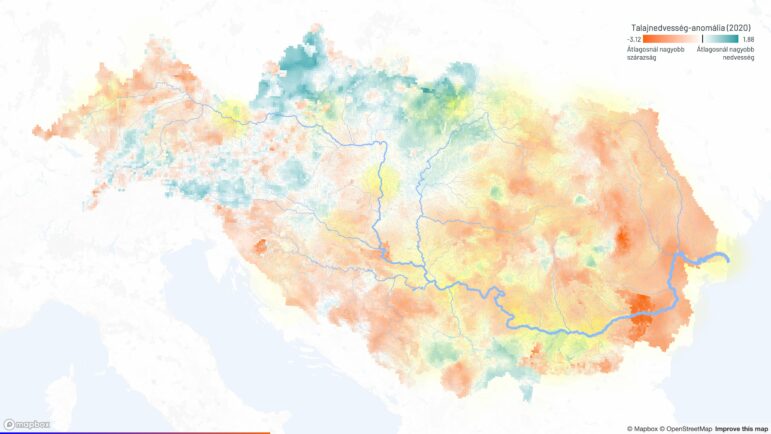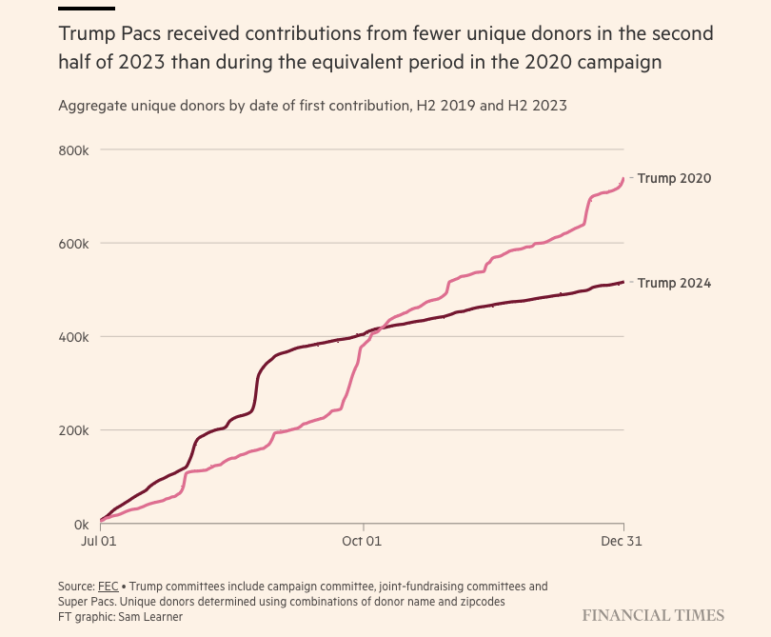

The Hungarian data journalism site Atlo looked into the long-term warming trend of the water in the Danube River. Image: Screenshot, Atlo team
Danube’s Warming Water, Missing US Railroad Safety Data, and Russian Election Anomalies
Sometimes missing data can be indicative of a larger, systemic problem. ProPublica scrutinized the number of discrepancies between incidents mentioned in US railroad worker lawsuits and on-the-job injuries and deaths reported to the relevant regulatory authority, which led to the discovery of loopholes in the country’s railroad safety monitoring mechanisms. Our curated list of the most interesting data journalism between March 11 and 24 also features a look at the consequences of a warming Danube river, anomalies in voter data for Russia’s recent election, cocaine seizures in Latin America, and this year’s winners of the Sigma Awards.
Missing US Railroad Safety Data
Nonprofit investigative newsroom ProPublica previously reported on the extreme lengths that the US railroad industry goes to claim that its safety record is better than it actually is. In this recent investigation, journalists examined more than 5,000 federal lawsuits brought against six large freight railroad companies in the last 15 years and compared them to the online railroad injury database managed by the Federal Railroad Administration. They found scores of injuries and at least two deaths that were not reported to the regulatory authority. A pattern emerged among the missing cases: the worker’s deaths or injuries could be argued as having resulted from a “personal health condition” or they were not visible soft-tissue injuries “that could have happened off duty.”
Warming Danube River
The Danube river, which flows through 10 European countries, has been warming steadily over the past five decades, according to a data analysis by Atlo Team — a visual and data journalism unit based in Hungary. By analyzing temperature data from 34 Danube monitoring stations, journalists found that the average annual temperature of the river has increased from a range of 8.5 — 11.5 degrees Celsius (47 — 52 degrees Fahrenheit) in 1965 to 11.4 — 14.2 degrees Celsius (52 — 57.5 degrees Fahrenheit) in 2015. The team also looked into how rising temperatures along the river could impact the operations of key power plants. This story is available in English and Hungarian.
Quenching Spain’s Thirst: Desalination Plants
Winter and early spring are usually times when reservoirs and aquifers are full, replenished in preparation for the drier, leaner days of summer. But in February, 75% of the population living in urban areas in the Spanish region of Catalonia were put on water rations, according to this report by El Diario, which stated that reservoir water levels are at the lowest since at least 1988. The story takes Spain’s thirst for water as a prompt to explore the history of desalination projects across the country, and the problems that have plagued various plants. Spain was a pioneer in this technology, and reporters look at various regions, including Catalonia, to chart their dependence on desalinated water, while also exploring what has gone wrong in places where investment has stalled or projects failed to deliver. The multipage project includes maps, charts, graphics, contracts, and satellite imagery. Complementing this story, see Spanish outlet Datadista’s data deep dive on water, charting how reservoirs in the south and east of the country are already at worrying low levels.
Ships on the Red Sea
Since November, Yemen’s Houthi rebels have been targeting global shipping vessels near the Bab el-Mandeb Strait at the southern end of the Red Sea, “a choke point for global maritime trade.” But there is an alternative route around the Cape of Good Hope in Southern Africa. This story by Bloomberg analyzes the details of nearly 10,000 commercial ships traveling on the Red Sea and close to the tip of South Africa between December 1, 2023 and March 10, finding that the tankers and cargo ships still attempting to sail along the Yemeni coast carry a higher-risk profile, veering older, and that there are now more ships with untraceable insurance making the journey. Ships with a higher-risk profile represented 8% of Red Sea journeys, up from 3.5% a year prior, and compared to only 0.8% of ships taking the longer route around the Cape of Good Hope. “All the reputable owners are avoiding the Red Sea and the Suez Canal,’’ one source said.
Gender Pay Gap in Latin America
Is the gender pay gap smaller in countries where women have higher levels of education? And are salaries of men and women more similar in Guyana or Guatemala? Hassel Fallas from La Data Cuenta, an independent data journalism outlet, decided to dig into figures from the UN Global Human Development Index and per capita income averages by gender to find out. She found that across the region, on average, for every $100 earned by a man, women earn $40 less, “a disparity that transcends borders, impacting the economy, and the independence of women throughout the region.” But there are marked differences across Latin America — see the interactive platform to drill down into national data and compare different countries. In Spanish and English.
Analyzing Russian Election Anomalies
Last week, Russian President Vladimir Putin extended his rule of the country for another six years when he won 87.3% of the vote in an election that has been criticized as neither free nor fair. The Kremlin’s election commission reported a record voter turnout of 77.5%. However, Russian independent news site Meduza examined data from individual polling stations released by the commission and found some peculiarities in the data. It reported that the statistical anomalies — including deviation from the standard bell-shaped curve and highly unusual round-number turnout and vote total figures — are “evidence of falsifications.” See also a similar data analysis by exiled independent media iStories that highlighted an anomaly of “high-speed voting,” citing an example of a polling station that achieved an average rate of 700 people voting per hour over seven hours.
Comparing Cocaine Seizures and Murder Rates

Image: Screenshot, InSight Crime
In this report from InSight Crime, there are two charts side by side: one showing cocaine seized in Ecuador by metric ton, a figure that surges precipitously upwards from 2019, and the other showing the homicide rate, which sees the exact same vertiginous increase from around 2020. This report — an in-depth analysis of cocaine seizures across Latin America — used data from national police departments, anti-narcotics teams, and defense ministries as well as from the UN Office on Drugs and Crime (UNODC) to explore the cocaine supply chain and scale of drug seizures across the continent. InSight Crime conducts daily monitoring for reports on cocaine seizures and filed public information requests to every country in Latin America and the Caribbean asking for data.
Who Owns and Who Rents in Brussels?
“Brussels has a rent problem,” the authors of this story on housing in the Belgian capital wrote. More than half of the city’s million residents, 54%, are tenants, who have seen rising rental prices while the waiting time for social housing “fluctuates between 10 and 16 years.” While tenants are becoming gradually poorer, the owners “are enriched by drawing annuities” from their property portfolios, the team at Médor, an independent cooperative media outlet, reported. They based their investigation — which they said offered an unseen-until-now portrait of the makeup of owners and renters in the city — on data work carried out by Hugo Périlleux, a researcher at the Free University of Brussels. They explored how rents have increased over time, mapped where owner-occupiers, renters, and social housing tenants live, charted the age of the housing stock, and dug into the energy efficiency in older houses. (This was published on March 7 but we flexed our data parameters to include it.)
Analyzing Supporters for a German Political Party

New surveys have found that large numbers of German voters who self-identify as “middle” or “middle-right” now express interest in voting for the country’s AfD party (blue figures), despite some state associations of the party being labeled as “right-extreme” by the German domestic intelligence agency. Image: Screenshot, Zeit Online
Support for Germany’s far-right populist political party, Alternative for Germany (AfD), has been growing in recent years. According to a report by German news site Zeit Online, almost eight million people indicated in surveys that they would like to vote for AfD, including a large number of citizens who self-identify as being “middle” or “middle-right” on the political spectrum. Zeit’s data journalists analyzed a dataset collected by the German Society for Electoral Studies and Leibniz Institute for the Social Sciences — containing information from interviews with 10,000 people twice a year — in an attempt to shed light on the composition and possible motivations of AfD’s potential voters.
Russian Media Mentions
How often are key political figures named in Russian media? And are they mentioned in a favorable or negative light? Ukrainian data agency Texty monitored the content of Russian media between April 2022 and February 2024 to find out. It managed to identify patterns in the 10 most commonly referenced Russian or foreign leaders. United States President Joe Biden and Ukrainian President Volodymyr Zelenskyy, who were mostly included in negative contexts, were the two most mentioned foreign politicians.
Bonus: Sigma Award 2024 Winners
Congratulations to the 10 winners of the latest Sigma Awards, which were picked from a total of 638 entries from 332 organizations in 80 countries/territories. The list includes three stories previously featured in GIJN’s Editor’s Pick – Top 10 Data Journalism Projects from 2023: an investigation into the demolition and modification of mosques in China, a deep dive into the algorithm determining risk scores for a Dutch welfare program, and an in-depth data analysis into extrajudicial killings in Bangladesh.
GIJN’s Top 10 in Data Journalism list is curated fortnightly. Send your suggestions to us.
 Laura Dixon is an associate editor at GIJN and a freelance journalist from the UK. She has reported from Colombia, the US, and Mexico, and her work has been published by The Times, The Washington Post, and The Atlantic. She has received fellowships from the IWMF and the Pulitzer Center.
Laura Dixon is an associate editor at GIJN and a freelance journalist from the UK. She has reported from Colombia, the US, and Mexico, and her work has been published by The Times, The Washington Post, and The Atlantic. She has received fellowships from the IWMF and the Pulitzer Center.
 Eunice Au is GIJN’s global team manager based in Budapest, Hungary. Previously, she was a correspondent for Singapore’s The Straits Times, and a journalist at Malaysia’s New Straits Times. She has also written for The Sun, Malaysian Today, and Madam Chair.
Eunice Au is GIJN’s global team manager based in Budapest, Hungary. Previously, she was a correspondent for Singapore’s The Straits Times, and a journalist at Malaysia’s New Straits Times. She has also written for The Sun, Malaysian Today, and Madam Chair.

















